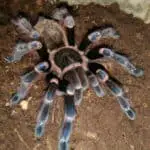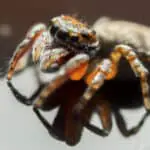As someone who loves animals, I have always been fascinated by spiders. Although many people fear them, I believe that they are some of the most interesting creatures on the planet. However, not all spiders are created equal, and some are much friendlier than others. In this article, I will explore the question: what is the friendliest spider?
When it comes to friendliness, there are a few different factors to consider. Some spiders are more docile and less likely to bite, while others are more interactive and playful. Additionally, some spiders are easier to care for as pets, making them a good choice for beginners. By taking all of these factors into account, we can determine which spiders are the friendliest overall.
Whether you are a spider enthusiast or simply curious about these fascinating creatures, this article will provide you with all the information you need to understand what makes a spider friendly and which species are the best pets. So let’s dive in and explore the world of friendly spiders!
Key Takeaways
- Not all spiders are created equal, and some are much friendlier than others.
- Factors such as docility, interactivity, and ease of care make some spiders friendlier than others.
- By understanding what makes a spider friendly, we can determine which species are the best pets.

Understanding Spiders
Defining Species
Spiders are a type of arachnid that are found all over the world. There are over 45,000 known species of spiders, each with their own unique characteristics. They range in size from tiny to large, and come in a variety of colors and shapes.
Nature of Spiders
Spiders are often misunderstood creatures. While some species can be aggressive or skittish, many are docile and harmless to humans. They are generally solitary creatures, and only come together during mating season.
Venomous Vs Non-Venomous
While all spiders have venom, not all spiders are dangerous to humans. In fact, many spiders have venom that is too weak to harm humans. However, there are some species of spiders that are venomous and can cause serious harm to humans. It is important to be able to identify venomous spiders and avoid them.
Unique Appearances
One of the most interesting things about spiders is their unique appearances. Some spiders have bright colors and patterns, while others have unusual shapes and sizes. Some spiders even have the ability to change color to blend in with their surroundings.
Overall, spiders are fascinating creatures that play an important role in the ecosystem. While some species can be dangerous to humans, many are harmless and even beneficial. By understanding more about spiders, we can learn to appreciate and respect these amazing creatures.
Friendliest Spiders
As someone who has always been fascinated by arachnids, I am frequently asked about the friendliest spider species. After doing some research and consulting with experts, I have found that tarantulas and jumping spiders are among the friendliest spider species out there.
Tarantula Species
Tarantulas are a popular choice for pet owners due to their docile nature. While some species can be more aggressive than others, many tarantulas are known for their calm and gentle demeanor. In fact, some tarantula species are so friendly that they are often used in educational programs and can even be handled by humans.
Some of the most popular pet tarantulas include the Chilean rose, Mexican redknee, and Brazilian black. These species are known for their docility and make great beginner spiders for those interested in keeping them as pets.
Jumping Spiders
Jumping spiders are another spider species known for their friendly demeanor. These spiders have an adorable appearance and are often described as having “cute” faces. They are also known for their curious and playful behavior.
The bold jumping spider and regal jumping spider are two species that are particularly friendly and make great pets. These spiders are active and love to explore their surroundings, making them a fun and interactive pet to have.
It’s important to note that even friendly spiders won’t necessarily want to be handled or cuddled. It’s important to respect their boundaries and handle them with care to avoid stressing them out.
Overall, tarantulas and jumping spiders are some of the friendliest spider species out there. While they may not be the cuddliest pets, they can make great additions to any spider enthusiast’s collection.
Pet Spiders
If you’re looking for a unique and low-maintenance pet, a spider might be just what you need. But which spiders make the best pets? In this section, I’ll cover the best spiders for beginners and how to handle pet spiders.
Best Spiders for Beginners
When it comes to pet spiders, beginners should start with a species that is unlikely to bite and easy to care for. Here are some of the best spiders for beginners:
- Curlyhair Tarantula: This species is widely bred in captivity and is one of the most popular pet spiders. They rarely have health problems and are easy to care for.
- Mexican Red-Knee Tarantula: This is often the first pet for spider enthusiasts. The females can live around 20 to 30 years while the males only live for about 10 years. They are quite docile and typically easy to handle.
- Chilean Rose Tarantula: This is an excellent example of a friendly tarantula. Though they may look scary, many tarantulas are calm, reserved, and unwilling to bite.
Handling Pet Spiders
Handling pet spiders can be intimidating, but it’s actually quite simple. Here are some tips for handling your pet spider:
- Always wash your hands before and after handling your spider to prevent the spread of bacteria.
- Use a soft brush to gently coax your spider onto your hand or a flat surface.
- Never grab your spider or try to force it onto your hand.
- If your spider seems agitated or stressed, put it back in its enclosure and try again later.
In conclusion, pet spiders can make great pets for beginners. Just make sure to choose a species that is easy to care for and handle your spider with care.
Spider Habitats
Spiders are found in different types of habitats, including forests, deserts, grasslands, and wetlands. Some spiders prefer to live in burrows, while others live in trees or on the ground. In this section, I will discuss the different types of spider habitats and the enclosure and tank requirements for keeping pet spiders.
Enclosure and Tank Requirements
When keeping pet spiders, it is important to provide them with a suitable enclosure or tank. The enclosure should be large enough for the spider to move around and have enough space to build a web or burrow. The enclosure should also have good ventilation and be easy to clean.
The type of enclosure or tank required will depend on the species of spider. Arboreal spiders, such as the Green Lynx spider, require a tall enclosure with branches or other climbing structures. Burrowing spiders, such as the Trapdoor spider, require a deep substrate for burrowing.
Habitats of Different Species
Different species of spiders have different habitat requirements. Some spiders, such as the Jumping spider, are found in a variety of habitats, including forests, grasslands, and deserts. Other spiders, such as the Fishing spider, are found near water and prefer wetland habitats.
Some spiders, such as the Portia Fimbriata, are known for their intelligence and problem-solving abilities. These spiders are found in tropical forests and prefer to live in the canopy.
Burrowing spiders, such as the Trapdoor spider, are found in dry habitats and prefer to live in burrows. Tree-dwelling species, such as the Golden Orb Weaver, are found in tropical and subtropical regions and prefer to build webs in trees.
In conclusion, spiders are found in a variety of habitats and have different enclosure and tank requirements. When keeping pet spiders, it is important to research the specific species to ensure that their habitat requirements are met.
Feeding Spiders
As with any living creature, spiders need food to survive. Most spiders are carnivores and feed on insects, although some larger species can eat small animals like lizards, frogs, rodents, and birds.
Some of the most common insects that spiders feed on include crickets, flies, aphids, roaches, and moths. Spiders are known to be fast hunters, and they use their web to trap their prey. Once the prey is caught, the spider injects it with venom to immobilize it and then consumes it.
It’s important to note that not all spiders are the same when it comes to their feeding habits. Some spiders, like the jumping spider species Portia Fimbriata, are known to be more opportunistic and will eat a wider variety of prey. Other spiders, like the orb-weaver spider, are more specialized and will only eat specific types of insects.
When it comes to feeding pet spiders, it’s essential to provide them with a diet that is appropriate for their species. Most pet spiders, like the Curlyhair Tarantula, can be fed a diet of crickets or other insects that can be purchased from pet stores. It’s important to make sure that the insects are healthy and not contaminated with pesticides or other harmful substances.
In conclusion, feeding spiders is an essential part of their survival, and it’s important to provide them with a diet that is appropriate for their species. Whether you are caring for a pet spider or simply observing spiders in the wild, understanding their feeding habits can help you appreciate these fascinating creatures even more.
Pricing of Pet Spiders
When it comes to pricing, pet spiders can vary greatly depending on the species and where you purchase them. Some spiders are relatively cheap, while others can be quite expensive.
Tarantulas are one of the most popular pet spiders, and their prices can range from around $20 to over $200 depending on the species. The cost of feeding a tarantula is relatively low, and they are generally easy to care for. However, some species can be quite aggressive and may not be suitable for beginners.
Jumping spiders are another popular choice for pet owners. These spiders are usually cheaper than tarantulas, with prices ranging from around $10 to $50. They are also relatively easy to care for, and their friendly demeanor makes them a great choice for beginners.
Other species, such as orb weavers and huntsman spiders, can be more difficult to find and may need to be caught in the wild. This can make them more expensive, as well as more difficult to care for.
Overall, the price of a pet spider will depend on the species and where you purchase it from. It’s important to do your research and make sure you’re getting a spider that is suitable for your experience level and budget.
Specific Spider Species
As a spider enthusiast, I have come across many species that are considered friendly. In this section, I will highlight some of the friendliest spider species that you can keep as pets.
Chilean Rose
The Chilean Rose, also known as the Chilean Rose Tarantula, is a popular pet spider due to its docile and calm nature. They are easy to care for and have a long lifespan, which makes them an ideal pet for beginners.
Brazilian Black
The Brazilian Black Tarantula is another docile species that is easy to care for. They are known for being calm and rarely bite. They are also one of the most popular pet tarantulas due to their shiny black color and large size.
Pink Toe
The Pink Toe, also known as the Antilles Pinktoe, is a small and colorful spider species that is very friendly. They are known for being active and curious, which makes them a joy to watch. They are also easy to care for and make great pets for beginners.
Mexican Redleg and Red Knee
The Mexican Redleg and Red Knee Tarantulas are both docile and easy to handle. They are also very colorful, which makes them a popular choice for pet owners. They are low maintenance and have a long lifespan, which makes them a great pet for beginners.
Greenbottle Blue Tarantula
The Greenbottle Blue Tarantula is a stunning spider species with bright blue and green colors. They are known for being active and friendly, which makes them a great pet for those who want an interactive spider. They are also easy to care for and have a long lifespan.
Curly Hair Tarantula
The Curly Hair Tarantula, also known as the Honduran Curly Hair, is a docile and friendly spider species. They are easy to care for and have a long lifespan, which makes them a great pet for beginners. They are also known for their unique curly hair, which makes them a popular choice for pet owners.
Desert Blonde
The Desert Blonde, also known as the Aphonopelma Chalcodes, is a docile and calm spider species. They are easy to care for and have a long lifespan, which makes them a great pet for beginners. They are also known for their beautiful golden color, which makes them a popular choice for pet owners.
Grammostola Pulchra and Rosea
The Grammostola Pulchra and Rosea are both docile and friendly spider species. They are easy to care for and have a long lifespan, which makes them a great pet for beginners. They are also known for their beautiful colors, which makes them a popular choice for pet owners.
Mexican Red Rump
The Mexican Red Rump Tarantula is a docile and friendly spider species. They are easy to care for and have a long lifespan, which makes them a great pet for beginners. They are also known for their unique red rump, which makes them a popular choice for pet owners.
Pink Zebra Beauty
The Pink Zebra Beauty, also known as the Costa Rican Zebra, is a docile and friendly spider species. They are easy to care for and have a long lifespan, which makes them a great pet for beginners. They are also known for their beautiful pink and black stripes, which makes them a popular choice for pet owners.
Black Widow
The Black Widow is a venomous spider species, but they are also known for being shy and non-aggressive towards humans. They are easy to care for and have a long lifespan, which makes them a great pet for experienced spider owners.
Huntsman Spider
The Huntsman Spider is a large and friendly spider species. They are known for being fast and active, which makes them a joy to watch. They are also easy to care for and have a long lifespan, which makes them a great pet for those who want an interactive spider.
Crab Spider
The Crab Spider is a small and friendly spider species. They are known for being active and curious, which makes them a joy to watch. They are also easy to care for and have a long lifespan, which makes them a great pet for beginners.
Orb Weaver
The Orb Weaver is a large and friendly spider species. They are known for being active and curious, which makes them a joy to watch. They are also easy to care for and have a long lifespan, which makes them a great pet for those who want an interactive spider.
Fishing Spider
The Fishing Spider is a large and friendly spider species. They are known for being active and curious, which makes them a joy to watch. They are also easy to care for and have a long lifespan, which makes them a great pet for those who want an interactive spider.
Green Lynx
The Green Lynx is a colorful and friendly spider species. They are
Frequently Asked Questions
What are some friendly spider breeds for beginners?
If you are new to keeping spiders as pets, consider starting with a jumping spider or a daddy longlegs. These species are generally harmless and easy to care for.
Which spider breeds make good pets?
Tarantulas are popular pets for spider enthusiasts. Rose hair tarantulas are a common and docile species that make great pets. Other tarantula species, such as the Mexican red knee and the Brazilian black, are also popular choices for pet owners.
Are tarantulas friendly to humans?
Tarantulas are generally not aggressive towards humans, but they can bite if they feel threatened. Most tarantula bites are not dangerous to humans, but they can be painful. It is important to handle tarantulas with care and respect their space.
Can spiders be affectionate?
Spiders are not capable of feeling emotions like affection. They are solitary creatures that do not form social bonds with humans or other spiders.
Do spiders enjoy being touched?
Spiders do not have the capacity to enjoy being touched or to feel pleasure. They are not social animals and do not seek out physical contact with humans or other spiders.
Are there any naturally friendly spiders?
Some species of jumping spiders, such as the Portia Fimbriata, are known for their friendly behavior towards humans. However, even friendly spiders may feel threatened and react defensively if they perceive a threat. It is important to handle all spiders with care and respect.








